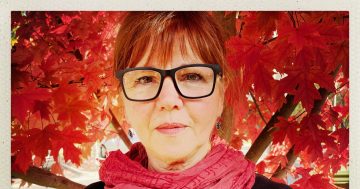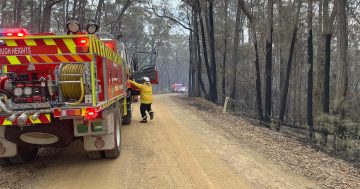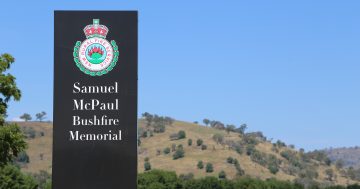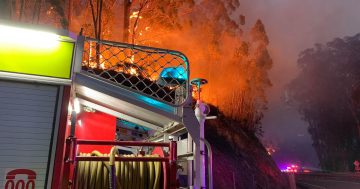
Jo Dodds’ partner Tony walking through the burned forest on their property after the March 2018 fire. Photo: Jo Dodds.
Jo Dodds can clearly remember standing at the mouth of the Bega River as an inferno threatened to engulf her home.
“My partner and I could see our house in the distance and see the fire coming closer and closer, burning across acres and acres of our land,” she recalled.
“Despite the smoke, we could see when our neighbour’s homes caught fire because when a forest burns it lets off grey smoke, but when a house burns, the smoke turns black.”
This was during the Tathra and District Fire of March 2018. Since then, Jo had also endured the Yankees Gap fire which burned for seven weeks in the winter of 2019, and the Black Summer bushfires of 2019/2020.
Jo is now the president of Bushfire Survivors for Climate Action. She said the 2018 Tathra fire was the one which changed everything.
“It was a wake-up call,” she said.
“It’s the one that changed my understanding of the situation we’re in when it comes to climate change.
“Before that, I just wasn’t aware how immediate and urgent the need for change was.”
She described the lead-up to the 2018 blaze as “pretty relaxed” as the days began to cool at the end of what was generally considered a safe summer.
“Then there was just one lethally hot, windy day,” Jo said.
“Over the course of four hours, the fire swept across the region towards my home.
“It was pretty traumatic for everyone trying to evacuate as gas cylinders were exploding around Tathra. Some people were sitting in boats being towed by cars because there weren’t enough seats in the vehicles to get out.”
When they were finally able to return, Jo and her partner were amazed to see their home unscathed.
“The fire had come within 30 to 40 metres of our house,” she said.
“But the savagery of that fire in just one day was astounding. The way it could burn through the centre of a small town, right to the ocean and over the cliffs, in areas you’d think a fire couldn’t reach.”
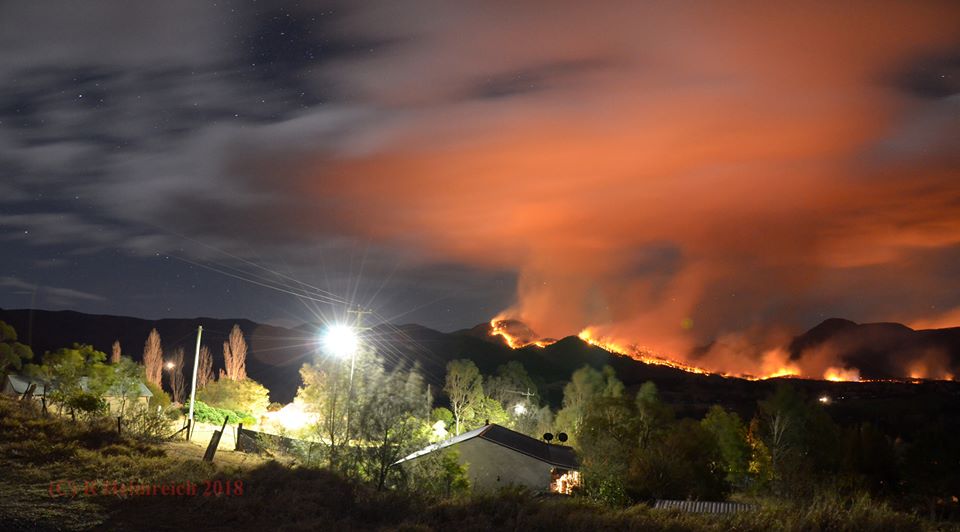
Night falls on Day 32 of the Yankees Gap Fire, 15 September 2018. Photo: Rachel Helmreich.
As the region shivers through winter, thoughts were already turning to summer and bushfire preparedness for the community.
The Emergency Leaders for Climate Action (ELCA) had already sounded the alarm of an approaching bushfire risk for the summer ahead, with our wet start to the year fuelling regrowth across NSW.
“There is a 50 per cent chance of yet another La Niña event this summer, which could mean wet conditions resulting in substantial regrowth in south-eastern NSW,” ELCA member and former ACT ESA Commissioner Major General Peter Dunn (Retd) said.
“The incredible rate of regrowth presents a fuel load management challenge when vegetation starts to dry out and is extremely concerning for the next hot and dry period.
“This means areas burned in the Black Summer fires may be at risk again.”
Jo said she could see this risk coming to fruition, watching the regrowth from the Tathra fire around her home.
“We’re a bit ahead of the curve [from the Black Summer fires]. Along my road, where the 2018 fire was the hottest, the trees are all burned but the regrowth is incredible,” she said.
“It’s this dense thicket of eucalyptus that’s close together but four or five metres high, which could spell disaster if there was a fire.”
She said the local council had enough funds to clear the roadside but didn’t have the resources to do further clearing into the forest. She worried that come the next fire, people would be left in a “precarious” situation.
“People assume our fire made us safer, but it’s clear as day we’re now at greater risk than ever, and knowing that the same situation is supercharging regrowth across millions of hectares of Black Summer fire grounds is frankly terrifying,” Jo said.
“There’s just no way this regrowth can be safely managed.”
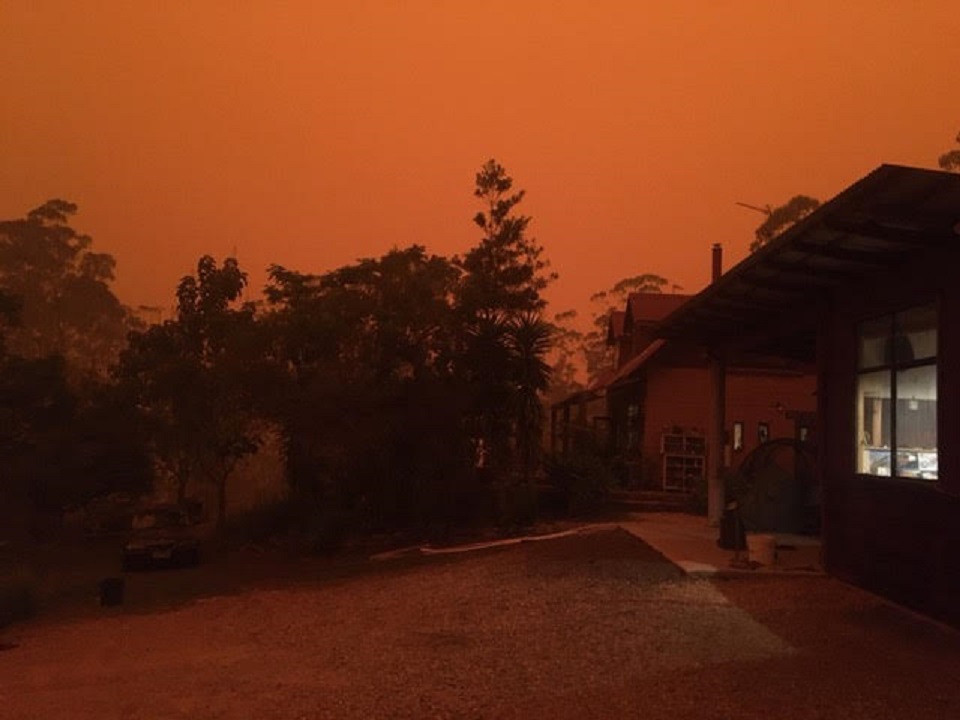
Jo’s home at 3 pm on New Year’s Eve 2019, during the Black Summer bushfires. She said by 5 pm, it was “pitch black”. Photo: Jo Dodd.
The NSW Rural Fire Service (RFS) spokesperson admitted the unusually wet conditions and record rainfall over the past two years had posed “significant challenges” to pre-season and post-season hazard reduction burns.
“Despite this, in 2021/22, the NSW RFS and partner agencies successfully treated 40,123 hectares, which has protected more than 43,000 properties,” they said.
“[Mitigation] crews have also been able to clear vegetation close to homes to reduce the fire risk.”
Before the 2019/20 Black Summer bushfires, the NSW RFS had 176 temporary mitigation crew members. This number had risen to more than 300 permanent members. The organisation has also welcomed a further 8,000 volunteers across the state.
“The NSW RFS continues to target hazard reduction in areas closest to where people live. This includes the work undertaken by the RFS mitigation crews,” the spokesperson said.
“Mitigation crews are playing a crucial role in undertaking preparatory work to ensure favourable weather windows can be capitalised on by RFS volunteer firefighters to conduct hazard reduction burns.”
But Jo worried these were short-term solutions.
“We’re facing a grim future if we’re not also urgently addressing what’s causing the problem,” she said.
“We’re in for a catastrophic situation we can’t control unless we get emissions under control.
The ELCA recently met with Federal Climate Change Minister Chris Bowen outlining similar concerns.
“We advised the Minister that ELCA wanted a 75 per cent reduction in emissions by 2030 (below 2005 levels), and we will be holding the government to account on ratcheting up ambition,” General Dunn said.
“There is no doubt what lies ahead for Australia will not be easy. Disasters will continue to test us … unless we change, future disasters will overwhelm the emergency services and our Australian Defence Forces initial response capacity.”
The ELCA has also continued its push to see the recommendations from the Bushfire Royal Commission implemented.
In the meantime, Jo had this message for politicians: “A non-partisan approach is the best way to keep the community safe in the future. Any politicising makes it worse for the people on the front lines.
“If governments haven’t addressed the recommendations and implemented measures to make us safer before that next hot, windy, lethal day, it will be very hard for anyone to say they didn’t know the risk.
“Please, act now.”
Original Article published by Claire Fenwicke on Riotact.







